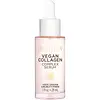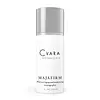What's inside
What's inside
 Key Ingredients
Key Ingredients

 Benefits
Benefits

 Concerns
Concerns

 Ingredients Side-by-side
Ingredients Side-by-side

Water
Skin ConditioningGlycerin
HumectantCaprylic/Capric Triglyceride
MaskingGlyceryl Oleate Citrate
EmulsifyingSqualane
EmollientAloe Barbadensis Leaf Juice
Skin ConditioningCamellia Japonica Seed Oil
EmollientSr-Hydrozoan Polypeptide-1
HumectantAhnfeltiopsis Concinna Extract
Skin ConditioningChamomilla Recutita Flower Extract
MaskingCitrus Aurantium Dulcis Flower Extract
Skin ConditioningJasminum Officinale Flower Extract
MaskingLeuconostoc/Radish Root Ferment Filtrate
AntimicrobialArnica Montana Flower Extract
MaskingHydrolyzed Jojoba Esters
Skin ConditioningSodium Hyaluronate
HumectantLecithin
EmollientPullulan
Hydrogenated Lecithin
EmulsifyingSilica
AbrasiveCaprylyl/Capryl Glucoside
CleansingXanthan Gum
EmulsifyingSclerotium Gum
Emulsion StabilisingCetearyl Alcohol
EmollientMaltodextrin
AbsorbentGlucose
HumectantCitric Acid
BufferingPotassium Sorbate
PreservativeEthylhexylglycerin
Skin ConditioningSodium Benzoate
MaskingPhenoxyethanol
PreservativeParfum
MaskingWater, Glycerin, Caprylic/Capric Triglyceride, Glyceryl Oleate Citrate, Squalane, Aloe Barbadensis Leaf Juice, Camellia Japonica Seed Oil, Sr-Hydrozoan Polypeptide-1, Ahnfeltiopsis Concinna Extract, Chamomilla Recutita Flower Extract, Citrus Aurantium Dulcis Flower Extract, Jasminum Officinale Flower Extract, Leuconostoc/Radish Root Ferment Filtrate, Arnica Montana Flower Extract, Hydrolyzed Jojoba Esters, Sodium Hyaluronate, Lecithin, Pullulan, Hydrogenated Lecithin, Silica, Caprylyl/Capryl Glucoside, Xanthan Gum, Sclerotium Gum, Cetearyl Alcohol, Maltodextrin, Glucose, Citric Acid, Potassium Sorbate, Ethylhexylglycerin, Sodium Benzoate, Phenoxyethanol, Parfum
Water
Skin ConditioningEthylhexyl Palmitate
EmollientIsododecane
EmollientGlycerin
HumectantCetyl Esters
EmollientPolyglyceryl-6 Distearate
EmulsifyingCaprylic/Capric Triglyceride
MaskingAcetyl Heptapeptide-9
Skin ConditioningGold
Cosmetic ColorantPalmitoyl Tetrapeptide-50
Skin ConditioningHeptapeptide-15 Palmitate
Skin ConditioningPalmitoyl Hexapeptide-52
Skin ConditioningPalmitoyl Heptapeptide-18
Skin ConditioningWithania Somnifera Root Extract
Skin ConditioningLeontopodium Alpinum Callus Culture Extract
AntioxidantSodium Hyaluronate
HumectantAnanas Sativus Fruit Extract
Skin ConditioningChamomilla Recutita Flower Extract
MaskingCalendula Officinalis Flower Extract
MaskingCentella Asiatica Extract
CleansingArnica Montana Flower Extract
MaskingHordeum Vulgare Extract
EmollientCucumis Sativus Seed Oil
EmollientSqualane
EmollientHelianthus Annuus Seed Oil
EmollientHydrolyzed Jojoba Esters
Skin ConditioningJojoba Esters
EmollientAllantoin
Skin ConditioningCitrus Aurantium Bergamia Fruit Oil
MaskingLavandula Angustifolia Flower Oil
MaskingCetearyl Alcohol
EmollientButylene Glycol
HumectantXanthan Gum
EmulsifyingHydroxypropyl Methylcellulose
Emulsion StabilisingPhytosterols
Skin ConditioningLecithin
EmollientCetyl Alcohol
EmollientSodium Acrylates Copolymer
Polyglyceryl-3 Beeswax
EmulsifyingCeteareth-20
CleansingTocopheryl Acetate
AntioxidantCeteth-10
EmulsifyingLaureth-4
EmulsifyingDimethicone Crosspolymer-3
Skin ConditioningDimethicone
EmollientLactic Acid/Glycolic Acid Copolymer
Skin ConditioningCitric Acid
BufferingPolyvinyl Alcohol
1,2-Hexanediol
Skin ConditioningVanillin
MaskingHydroxyacetophenone
AntioxidantWater, Ethylhexyl Palmitate, Isododecane, Glycerin, Cetyl Esters, Polyglyceryl-6 Distearate, Caprylic/Capric Triglyceride, Acetyl Heptapeptide-9, Gold, Palmitoyl Tetrapeptide-50, Heptapeptide-15 Palmitate, Palmitoyl Hexapeptide-52, Palmitoyl Heptapeptide-18, Withania Somnifera Root Extract, Leontopodium Alpinum Callus Culture Extract, Sodium Hyaluronate, Ananas Sativus Fruit Extract, Chamomilla Recutita Flower Extract, Calendula Officinalis Flower Extract, Centella Asiatica Extract, Arnica Montana Flower Extract, Hordeum Vulgare Extract, Cucumis Sativus Seed Oil, Squalane, Helianthus Annuus Seed Oil, Hydrolyzed Jojoba Esters, Jojoba Esters, Allantoin, Citrus Aurantium Bergamia Fruit Oil, Lavandula Angustifolia Flower Oil, Cetearyl Alcohol, Butylene Glycol, Xanthan Gum, Hydroxypropyl Methylcellulose, Phytosterols, Lecithin, Cetyl Alcohol, Sodium Acrylates Copolymer, Polyglyceryl-3 Beeswax, Ceteareth-20, Tocopheryl Acetate, Ceteth-10, Laureth-4, Dimethicone Crosspolymer-3, Dimethicone, Lactic Acid/Glycolic Acid Copolymer, Citric Acid, Polyvinyl Alcohol, 1,2-Hexanediol, Vanillin, Hydroxyacetophenone
 Reviews
Reviews

Ingredients Explained
These ingredients are found in both products.
Ingredients higher up in an ingredient list are typically present in a larger amount.
Arnica Montana Flower is more commonly known as Wolf's Bane. While this flower has been used in traditional medicine, its skin benefits are in question.
The FDA considers Wolf's Bane to be an unsafe herb. They advise against taking it orally or applying it to broken skin.
Wolf's Bane has been said to have anti-inflammatory properties. However, studies are conflicting about whether this is true.
According to the Final report on the safety assessment of Arnica montana, this plant has not been found to cause dermal irritation.
This flower contains numerous fatty acids such as palmitic, linoleic, myristic, and linolenic acids. The presence and amount of fatty acids depends on where the flower is harvested.
Like other flowers, this ingredient has a natural fragrance. It can also be used to mask, or cover, the unpleasant scents from other ingredients.
Learn more about Arnica Montana Flower ExtractThis ingredient is an emollient, solvent, and texture enhancer. It is considered a skin-softener by helping the skin prevent moisture loss.
It helps thicken a product's formula and makes it easier to spread by dissolving clumping compounds.
Caprylic Triglyceride is made by combining glycerin with coconut oil, forming a clear liquid.
While there is an assumption Caprylic Triglyceride can clog pores due to it being derived from coconut oil, there is no research supporting this.
Learn more about Caprylic/Capric TriglycerideCetearyl alcohol is a mixture of two fatty alcohols: cetyl alcohol and stearyl alcohol. It is mainly used as an emulsifier. Emulsifiers help prevent the separation of oils and products. Due to its composition, it can also be used to thicken a product or help create foam.
Cetearyl alcohol is an emollient. Emollients help soothe and hydrate the skin by trapping moisture.
Studies show Cetearyl alcohol is non-toxic and non-irritating. The FDA allows products labeled "alcohol-free" to have fatty alcohols.
This ingredient is usually derived from plant oils such as palm, vegetable, or coconut oils. There is debate on whether this ingredient will cause acne.
Due to the fatty acid base, this ingredient may not be Malassezia folliculitis safe.
Learn more about Cetearyl AlcoholChamomilla Recutita Flower Extract comes from the Chamomile flower.
Chamomile is rich in antioxidants and has anti-inflammatory properties. Several compounds found in chamomile help with soothing, such as bisbolol.
Antioxidant components in chamomile make it an effective ingredient to help slow the signs of aging. Antioxidants help fight free-radical molecules, or molecules that may damage your skin.
Essential oils from chamomile have been found to improve wound healing due to its antimicrobial properties.
Ancient Greeks and Egyptians used Chamomile to treat skin redness and dryness. Chamomile has also been used to help treat stomach issues.
Learn more about Chamomilla Recutita Flower ExtractCitric Acid is an alpha hydroxy acid (AHA) naturally found in citrus fruits like oranges, lemons, and limes.
Like other AHAs, citric acid can exfoliate skin by breaking down the bonds that hold dead skin cells together. This helps reveal smoother and brighter skin underneath.
However, this exfoliating effect only happens at high concentrations (20%) which can be hard to find in cosmetic products.
Due to this, citric acid is usually included in small amounts as a pH adjuster. This helps keep products slightly more acidic and compatible with skin's natural pH.
In skincare formulas, citric acid can:
While it can provide some skin benefits, research shows lactic acid and glycolic acid are generally more effective and less irritating exfoliants.
Most citric acid used in skincare today is made by fermenting sugars (usually from molasses). This synthetic version is identical to the natural citrus form but easier to stabilize and use in formulations.
Read more about some other popular AHA's here:
Learn more about Citric AcidGlycerin is already naturally found in your skin. It helps moisturize and protect your skin.
A study from 2016 found glycerin to be more effective as a humectant than AHAs and hyaluronic acid.
As a humectant, it helps the skin stay hydrated by pulling moisture to your skin. The low molecular weight of glycerin allows it to pull moisture into the deeper layers of your skin.
Hydrated skin improves your skin barrier; Your skin barrier helps protect against irritants and bacteria.
Glycerin has also been found to have antimicrobial and antiviral properties. Due to these properties, glycerin is often used in wound and burn treatments.
In cosmetics, glycerin is usually derived from plants such as soybean or palm. However, it can also be sourced from animals, such as tallow or animal fat.
This ingredient is organic, colorless, odorless, and non-toxic.
Glycerin is the name for this ingredient in American English. British English uses Glycerol/Glycerine.
Learn more about GlycerinThis ingredient is created by cleaving jojoba oil to remove all fatty acids, fatty alcohols, and wax esters.
Hydrolyzed Jojoba Esters has emollient, stabilizing, and hair-conditioning properties.
Lecithin is a term for a group of substances found in the cell membranes of plants, animals, and humans. They are made up of mixture of phospholipids.
This ingredient has emollient and emulsifying properties.
As an emollient, lecithen helps soften the skin and creates a barrier to keep moisture in.
As an emulsifier, it also helps prevent water and oil ingredients from separating. Lecithin can also help ingredients be better absorbed by the skin.
This is because the phospholipids in lecithin produce liposomes. Liposomes help other ingredients get through the skin barrier.
Depending on the source of this ingredient, lecithin may not be fungal acne safe. This is because some sources of lecithin come from soybean oil, which may feed the malassezia yeast that feeds fungal acne.
We recommend reaching out to the brand you are purchasing from to inquire about the source of their lecithin.
Some other names for this ingredient include soy lecithin and deoiled soy lecithin.
Learn more about LecithinSodium Hyaluronate is hyaluronic acid's salt form. It is commonly derived from the sodium salt of hyaluronic acid.
Like hyaluronic acid, it is great at holding water and acts as a humectant. This makes it a great skin hydrating ingredient.
Sodium Hyaluronate is naturally occurring in our bodies and is mostly found in eye fluid and joints.
These are some other common types of Hyaluronic Acid:
Learn more about Sodium HyaluronateSqualane is an emollient that helps the skin hold onto moisture. It's an oily liquid that occurs naturally in certain types of fish and plant oils.
Because squalane boosts hydration in the skin, it also comes with plenty of benefits: it is an antioxidant and can help fight free radicals and skin damage. Squalane is also found to have a detoxifying effect when applied.
Squalane comes from squalene, which occurs naturally within the sebum of our skin. It is one of the oils our skin produces to keep itself hydrated. Squalane is the hydrogenated version of squalene and has a longer shelf life.
Research shows that squalane is non-irritating (even at 100% concentration).
In general, it's a fantastic ingredient. It does a great job at hydrating the skin, and it's suitable for those with sensitive skin.
The source of squalane may impact malassezia / fungal acne. This is because olive oil derived squalane can contain impurities such as fatty acids and plant waxes. Sugarcane derived squalane is recommended for anyone with malassezia concerns.
Is squalane vegan?
This depends on the source. Squalane can be derived from both plants and animals. Most squalane used in skincare comes from plants.
Please note: the source of squalane is only known if disclosed by the brand. We recommend reaching out to the brand if you have any questions about their squalane.
Read more about squalene with an "e".
Is squalane an oil?
Squalane is often called an oil, but it’s technically not; it’s a hydrocarbon, meaning it’s only made of carbon and hydrogen, unlike true oils which are triglycerides made of fatty acids and glycerol.
The term “oil-free” isn’t regulated, so companies can define it however they want. Some exclude all oils, while others just avoid mineral oil or comedogenic oils.
While some people avoid oils thinking they cause breakouts, the right kind of oil (or oil-like ingredient like squalane) can actually help balance and hydrate your skin. It’s worth testing out simple oils or squalane to see what works best for your skin.
Learn more about SqualaneWater. It's the most common cosmetic ingredient of all. You'll usually see it at the top of ingredient lists, meaning that it makes up the largest part of the product.
So why is it so popular? Water most often acts as a solvent - this means that it helps dissolve other ingredients into the formulation.
You'll also recognize water as that liquid we all need to stay alive. If you see this, drink a glass of water. Stay hydrated!
Learn more about WaterXanthan gum is used as a stabilizer and thickener within cosmetic products. It helps give products a sticky, thick feeling - preventing them from being too runny.
On the technical side of things, xanthan gum is a polysaccharide - a combination consisting of multiple sugar molecules bonded together.
Xanthan gum is a pretty common and great ingredient. It is a natural, non-toxic, non-irritating ingredient that is also commonly used in food products.
Learn more about Xanthan Gum